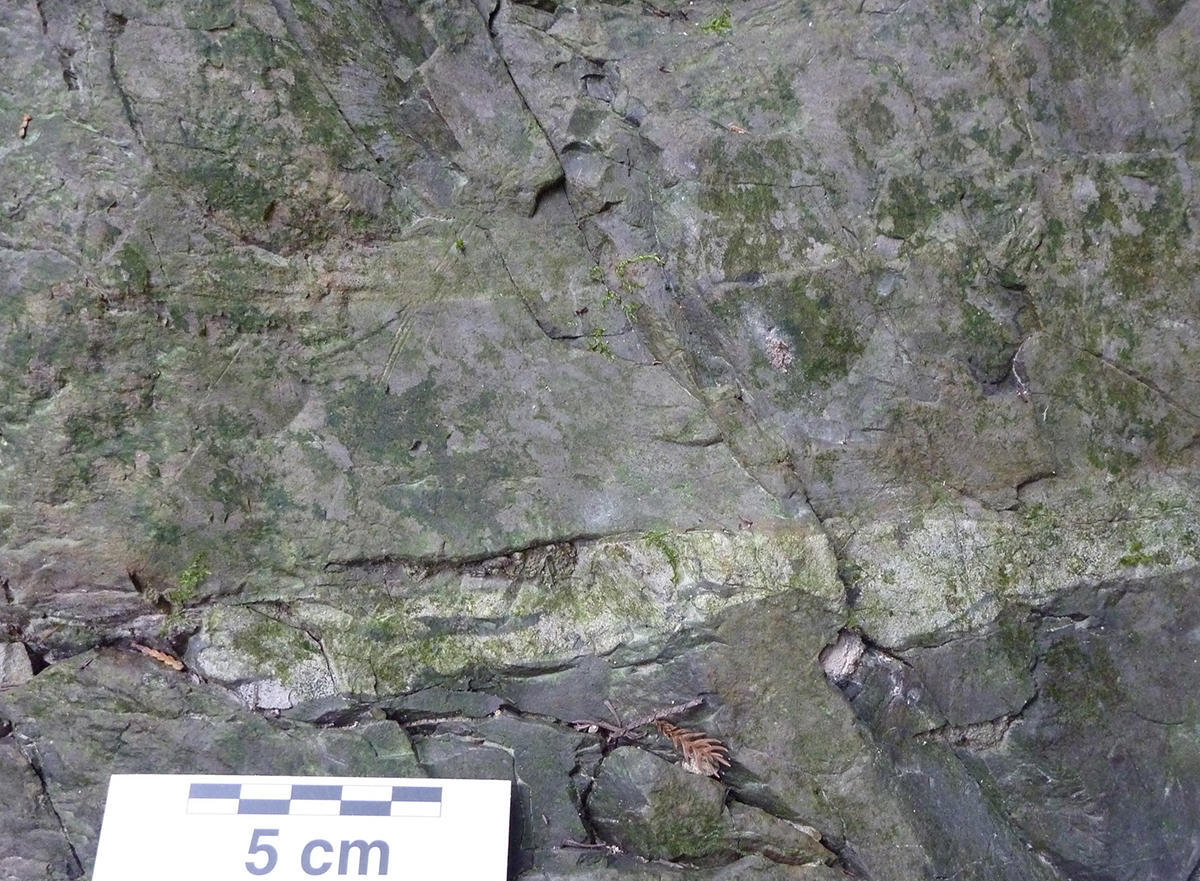Bulletin of the Geological Survey of Japan Top Page
Bulletin of the Geological Survey of Japan Vol.67 No.4 (2016)
Cover photograph | Table of Contents | Abstract
Cover photograph
Tuffaceous mudstone of the Takikubo Formation in the Izumi Group, Kan-onji City, Kagawa Prefecture
The Izumi Group, consisting of the Upper Cretaceous marine sediments, is distributed along the northern side of the Median Tectonic Line in southwestern Japan. The Izumi Group is divided into the northern marginal facies of shallow marine sediments that unconformably overlie the Ryoke metamorphic and plutonic rocks, and the main facies of deep marine sediments. Radiolarian fossils were analyzed to estimate the depositional age of the Takikubo Formation of the main facies around Kan-onji City, Kagawa Prefecture. The photograph shows an outcrop of tuffaceous mudstone of the Takikubo Formation at the northern foot of Mt. Unpenji, Sanuki Mountains. The sample (ID60 : GSJ R109145) was collected from this tuffaceous mudstone above a thin tuff bed showing normal grading with erosional base. Cross sections of Inoceramus sp. are visible just below the tuff bed (above the scale of 5 cm in the photograph). The outcrop yields both macro- and micro-fossils. The depositional age of the Takikubo Formation in the Kan-onji district indicated by radiolarian fossils from several samples is early Late Campanian, Late Cretaceous.
(Photograph and Caption by Atsushi Noda)
Table of Contents
All the pages PDF : 67_04_full.pdf [7.6MB]
| Title | Author | |
|---|---|---|
| Article | ||
| Study on chemical composition of fluorescent opal specimens in the Shikaribetsu area, central Hokkaido |
Yutaka Kanai, Yoshiko Tachibana, Masahiro Aoki, Chizuko Okazaki, Yasuyuki Oppata, Naoki Mita and Hiroharu Matsueda(p101-110)
|
67_04_01.pdf [1.8MB] |
| Iron removal from clayey weathered granite using magnetic separation and classification |
Yuki Tsunazawa, Sadahisa Sudo and Tetsuichi Takagi(p111-118)
|
67_04_02.pdf[1MB] |
| Report | ||
| Late Cretaceous radiolarian assemblages obtained from the Izumi Group in the Kan-onji district, eastern Shikoku, Japan |
Atsushi Noda and Toshiyuki Kurihara (p119-131)
|
67_04_03.pdf [4.2MB] |
Abstract
Study on chemical composition of fluorescent opal specimens in the Shikaribetsu area, central Hokkaido
Yutaka Kanai, Yoshiko Tachibana, Masahiro Aoki, Chizuko Okazaki, Yasuyuki Oppata, Naoki Mita and Hiroharu Matsueda
Two specimens of fluorescent opal in the Shikaribetsu area, central Hokkaido, were studied on their chemical compositions of fluorescent layers. Some characteristic properties for their chemical compositions were elucidated, although clear relationship between chemical element and fluorescent color was not found out. They contained as much as several hundred ppm of Li, Be, Ga, As, Rb, Cs and several thousand ppm of Sb. Alkali elements (Na, K, Li, Rb, Cs) and alkali earth elements (Ca, Sr, Ba) showed relatively small variations among the parts showing different color fluorescence in one sample. Further study on organic materials is necessary for better understanding of the fluorescence phenomenon.
Iron removal from clayey weathered granite using magnetic separation and classification
Yuki Tsunazawa, Sadahisa Sudo and Tetsuichi Takagi
Weathered granite has been expected to be an alternative material for potteries. Weathered granite, known as“ Ao-saba”, contains kaolin clay at around 10 % and this kaolin clay can be recovered by elutriation. However, elutriation residue contains colored minerals like biotite containing iron, which is not appropriate for raw materials for potteries. To use elutriation residue as raw materials, colored minerals have to be removed. This study applied classification and magnetic separation to removal of colored minerals from clayey weathered granite. Classification tests revealed that colored minerals like biotite were only contained in a smaller grain group of elutriation residue. This result meant that classification was effective for recovery of a bigger grain group of elutriation residue where colored minerals did not exist. Then, magnetic separation tests were conducted to remove biotite from a smaller grain group of elutriation residue. In magnetic separation tests, colored minerals were completely removed from any size of elutriation residue. Therefore, it was demonstrated that classification and magnetic separation were an effective method for iron removal from clayey weathered granite.
Late Cretaceous radiolarian assemblages obtained from the Izumi Group in the Kan-onji district, eastern Shikoku, Japan
Atsushi Noda and Toshiyuki Kurihara
Radiolarian fossil analyses were conducted to determine the depositional age of the Izumi Group, eastern Shikoku. Fourteen of total 19 samples yielded radiolarian fossils. Most samples contain Dictyomitra koslovae and Amphipyndax tylotus, and do not include Clathrocyclas tintinnaeformis, Myllocercion acineton, or Clathrocyclas gravis. Those assemblages can be correlated with the Amphipyndax tylotus assemblage zone of Yamasaki (1987), the Amphipyndax tylotus interval zone of Hollis and Kimura (2001), and the Archaeodictyomitra lamellicostata zone of Hashimoto et al. (2015). Therefore, the depositional age of the Izumi Group in this district is estimated to be early Late Campanian, Late Cretaceous.
Geological Survey of Japan, AIST
- About GSJ
- Our Activities
- Purchase guide
-
Publications and Database
- information
- Bulletin of the Geological Survey of Japan
- bull2025(Vol.76)
- bull2024(Vol.75)
- bull2023(Vol.74)
- bull2022(Vol.73)
- bull2021(Vol.72)
- bull2020(Vol.71)
- bull2019(Vol.70)
- bull2018(Vol.69)
- bull2017(Vol.68)
- bull2016(Vol.67)
- bull2015(Vol.66)
- bull2014(Vol.65)
- bull2013(Vol.64)
- bull2012(Vol.63)
- bull2011(Vol.62)
- bull2010(Vol.61)
- bull2009(Vol.60)
- bull2008(Vol.59)
- bull2007(Vol.58)
- bull2006(Vol.57)
- bull2005(Vol.56)
- bull2004(Vol.55)
- bull2003(Vol.54)
- bull2002(Vol.53)
- bull2001(Vol.52)
- Bulletin of the Geological Survey of Japan(old)
- Annual Report on Active Fault and Paleoearthquake Researches
- Reports, Geological Survey of Japan
- CCOP-GSJ Groundwater Project Report
- CCOP Technical Bulletin
- Cruise Report
- Geological Hazards
- Learning and Education
- GSJ Database Collection
- Collection of links


